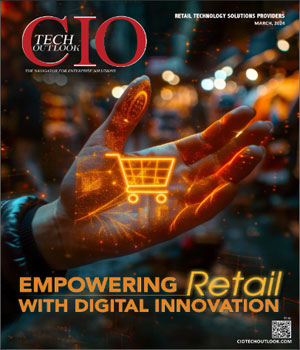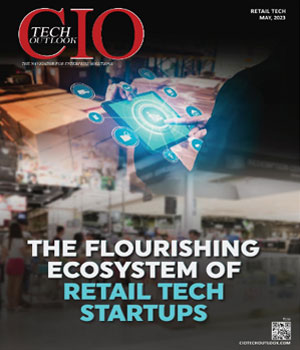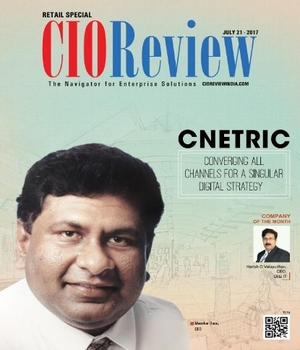
The Holy-Grail Of Retail Digital Transformation: Capturing In-Store Data Through Computer Vision
Vijay Gabale, Co-Founder And CTO, Infilect Technologies | Wednesday, 21 August 2019, 03:44 IST
 With the introduction of smart-phones and cloud-computing, Consumer Packaged Goods (CPG) organizations and Retailers have been re-energizing and strengthening various retail operations through digital transformation. Digital transformation of retail operations today not only entails digitizing different operations as electronic records but also necessitates deriving decision-influencing insights from these digital records. Digital records, i.e., data, and data driven insights when available for the right stakeholder at the right time can significantly improve operational efficiencies, saving cost and improving sales.
With the introduction of smart-phones and cloud-computing, Consumer Packaged Goods (CPG) organizations and Retailers have been re-energizing and strengthening various retail operations through digital transformation. Digital transformation of retail operations today not only entails digitizing different operations as electronic records but also necessitates deriving decision-influencing insights from these digital records. Digital records, i.e., data, and data driven insights when available for the right stakeholder at the right time can significantly improve operational efficiencies, saving cost and improving sales.
As the end-consumers or shoppers also adopt the newer digital technologies, digitizing the First-MomentOf-Truth (FMOT, pronounced EFF-mot) plays a crucial role to gain instantaneous and accurate insights into shopper behavior, in order to improve retail operational efficiencies. The FMOT (a term coined by and credited to Procter & Gamble), is the 3-7 seconds after a shopper, for instance, first encounters a product on a store shelf or a merchandize in a retail store. It is in these precious few seconds, P&G contends, that marketers have the best chance of converting a browser into a buyer by appealing to their senses, values and emotions. Retail operations that lead to better FMOT thus evidently result in higher sales.
While FMOT can happen on any digital (e.g., social media) or physical (e.g., billboard advertisement) channel, it is most imperative when shoppers enter a retail store. If you are a CPG brand and if shoppers entering the store do not spot your merchandising displayed on the shelf, they may not get attracted to your products and services. If a shopper does not find a particular product of a particular brand on the shelf, she will end up buying a different product of a different brand (or may not buy a shampoo bottle at all, in which case it is one less sale for a retailer).
“Presence and compliance of products on retail shelves is just one of FMOTs that affects the eventual sales of the products”
A recent analytics survey states that out of stocks (OOS, absence of products) have been at 8 percent in retail for the last 20 years. This evidently has adverse effects on FMOT for consumers if they don't find the products that they desire. A survey of 300 senior CPG executives estimated that CPG organizations could be losing between 1–5 percent of annual sales every year due to poor in-store execution and compliance. CPG brands can thus achieve a significant jump in sales simply by making themselves more visible on shelves and thus optimizing their execution process for FMOT.
Presence and compliance of products on retail shelves is just one of FMOTs that affects the eventual sales of the products. Pricing of products, merchandising of retail shelves, promotions and offers, and even the time spent by CPG merchandisers with retail store owners plays a crucial role in ensuring that CPG brands meet or exceed their sales targets. India’s fast-moving consumer goods (FMCG) industry alone, pumps an estimated USD 1 billion or more on in-store execution every year. However, more than 60 percent of spends allocated for in-store execution of visual elements etc. are hoarded in the supply chain, and don’t actually get deployed in the market. How do we digitize such ‘in-store’ retail operations such as product presence, or merchandise promotions?
Traditionally, CPG organizations and retailers have been recording such data, albeit with 1 percent to 2 percent sampling of stores or store shelves, by doing manual human-driven audits. Many a times, they make assumptions based on sales or supply chain data collected via product scans, or distribution invoices, or distribution orders. A few organizations purchase sample-based store observation data from vendors such as IRI, or Nielsen. There are several problems with methodologies.
On average, field execution representatives for brands are in stores 45 to 60 minutes every few weeks, and responsible for thousands of SKUs. Their ability to systematically and consistently inspect and report on the non-compliant conditions is inherently limited. CPG companies already have a record of what’s shipped to stores and when. The problem is, shipments don't reflect consumer behavior and first moment of truth at the retail level. Products and merchandise may be present in the inventory or back-office storage systems but not on the shelves. Their execution may get delayed. A lot of inventory may expire. Sales data, for these reasons, cannot be used to extrapolate what is OOS and the corresponding FMOT.
How should then CPG organizations and retailers collect in-store product availability and shopper interactions data that is accurate, instantaneous, and at scale? Data that affects FMOT and the eventual sales? This is where Computer Vision (CV) and Image Recognition (IR) comes into the picture. With the advent of Artificial Intelligence (AI), the availability of large-scale data (captured via mobile phones and camera sensors), and advancements in computing (Graphics Processing Units), it is now possible to record photos and videos of product availability in the store and consumer interactions, and process such rich multimedia to derive FMOT insights.
Digitizing retail shelves via IR is just one of the FMOTs that we can measure and optimize. Moreover, as we observed, insights and actions derived from digitizing retail shelves can transform number of operations inside a CPG brand or a retail store. Therefore, it is quite evident that the holy-grail of retail digital transformation truly lies in capturing in-store data. Advanced technologies such as AI, CV, IR can digitize such data and truly revolutionize retail industries, cutting down wastage of products, improving efficiency of retail supply-chain, and thus cutting down time and cost for end-consumers.
CIO Viewpoint
Paving the Way for Technology First Retail
By Abhrasnata Das
Predictive Analytics In Supply Chain Management
By Ajay Yadav, Head It (North), Arshiya Rail Infrastructure
Never Let The Good Crises Go Into Waste,...
By Ashok Jade, CIO, Shalimar Paints
CXO Insights
Maneuvering the Digital Transformation in Retail
By Janifha Evangeline
Smart Retail Converting Shop Visitors To Customers
By Dr. Dinesh Chandrasekar, VP, Chief Solutions & Innovation Head, Pactera
Importance Of Differentiated Customer Experience




.jpg)


.jpg)
.jpg)




